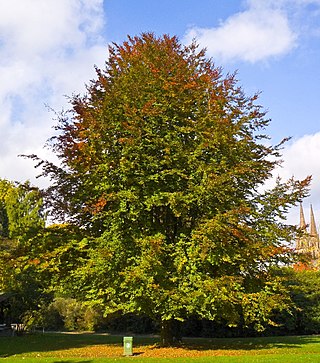
The Fagaceae are a family of flowering plants that includes beeches, chestnuts and oaks, and comprises eight genera with about 927 species. Fagaceae in temperate regions are mostly deciduous, whereas in the tropics, many species occur as evergreen trees and shrubs. They are characterized by alternate simple leaves with pinnate venation, unisexual flowers in the form of catkins, and fruit in the form of cup-like (cupule) nuts. Their leaves are often lobed, and both petioles and stipules are generally present. Their fruits lack endosperm and lie in a scaly or spiny husk that may or may not enclose the entire nut, which may consist of one to seven seeds. In the oaks, genus Quercus, the fruit is a non-valved nut called an acorn. The husk of the acorn in most oaks only forms a cup in which the nut sits. Other members of the family have fully enclosed nuts. Fagaceae is one of the most ecologically important woody plant families in the Northern Hemisphere, as oaks form the backbone of temperate forest in North America, Europe, and Asia, and are one of the most significant sources of wildlife food.

The black-footed shrew is a species of mammal in the family Soricidae. It is endemic to northern and central Sulawesi, Indonesia where it lives on the floor of the tropical forests. The International Union for Conservation of Nature has assessed its conservation status as being of "least concern".

The Sulawesi flying fox or Sulawesi fruit bat is a species of megabat endemic to Indonesia. It is classified as "Vulnerable" by the IUCN due to unsustainable levels of hunting.
Lithocarpus dodonaeifolius is a species of tree in the family Fagaceae. L. dodonaeifolius is a medium-sized tree, up to 9 m (30 ft) tall. It is endemic to Taiwan and only occurs in the Hengchun Peninsula in the extreme south of the country. It grows in mixed mesophytic forests at altitudes of 500–1,500 m (1,600–4,900 ft).
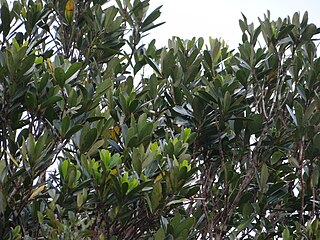
Lithocarpus formosanus is a species of tree in the family Fagaceae. L. formosanus is a medium-sized tree with crooked trunk and many branches. It is endemic to Taiwan as it only occurs in the Hengchun Peninsula in the extreme south of the country. It grows in mixed mesophytic forests at altitudes of 100–500 m (330–1,640 ft). Only single population of fewer than 50 individuals survives.
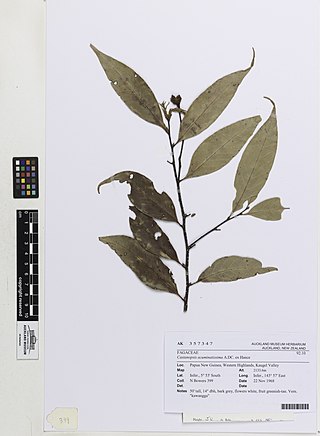
Castanopsis acuminatissima is an evergreen tree native to Southeast Asia and New Guinea. It is known by a variety of common names over its range, including white oak, New Guinea oak, Papua New Guinea oak, ki riung, ko-duai, ko-soi, ko-mat, meranak, and riung anak.

The Cardamom Mountains rain forests is a tropical moist broadleaf forest ecoregion in Southeast Asia, as identified by the WWF. The ecoregion covers the Cardamom Mountains and Elephant Mountains and the adjacent coastal lowlands in eastern Thailand and southwestern Cambodia, as well as the Vietnamese island of Dao Phu Quoc.
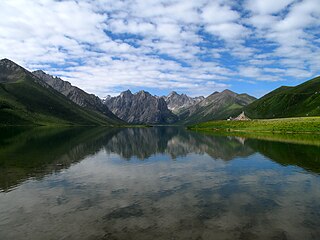
The flora of China consists of a diverse range of plant species including over 39,000 vascular plants, 27,000 species of fungi and 3000 species of bryophytes. More than 30,000 plant species are native to China, representing nearly one-eighth of the world's total plant species, including thousands found nowhere else on Earth. China's land, extending over 9.6 million km, contains a variety of ecosystems and climates for plants to grow in. Some of the main climates include shores, tropical and subtropical forests, deserts, elevated plateaus and mountains. The events of the continental drift and early Paleozoic Caledonian movement also play a part in creating climatic and geographical diversity resulting in high levels of endemic vascular flora. These landscapes provide different ecosystems and climates for plants to grow in, creating a wide variety of different flora spanning over not just China, but different parts of the world.

Notholithocarpus densiflorus, commonly known as the tanoak or tanbark-oak, is a broadleaf tree in the family Fagaceae, and the type species of the genus Notholithocarpus. It is native to the far western United States, particularly Oregon and California. It ranges from 15–40 meters in height, with a trunk diameter of 60–190 centimeters.
Didymocheton mollissimus is a species of tree in the family Meliaceae. It ranges from eastern India and Bangladesh to southern China, Myanmar, Thailand, Peninsular Malaysia, Borneo, Sumatra, Java, the Lesser Sunda Islands, and the Philippines, where it grows in lowland tropical moist forests.

Gunung Ambang Nature Reserve is a preserved area in the north of the island of Sulawesi in Indonesia. It is in a mountainous, little-explored region and contains a large number of indigenous plants and animals.
Lithocarpus caudatifolius is a tree in the beech family Fagaceae. The specific epithet caudatifolius means "leaf with caudate apex".
Lithocarpus coopertus is a tree in the family Fagaceae. The specific epithet coopertus means "covered over", referring to the acorn.
Lithocarpus daphnoideus is a tree in the family Fagaceae. The specific epithet daphnoideus means "like Daphne", referring to the genus Daphne and its leaves.
Lithocarpus corneri is a tree in the beech family Fagaceae. It is named for the English botanist E. J. H. Corner.
Lithocarpus gracilis is a tree in the beech family Fagaceae. The specific epithet gracilis is from the Latin meaning "slender", referring to the twigs.

The Sulawesi montane rain forests is a tropical moist forest ecoregion in Indonesia. It includes the highlands of Sulawesi.
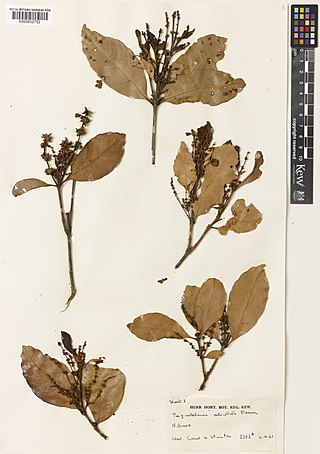
Trigonobalanus verticillata is a species of plant in the family Fagaceae. It is a tree native to Borneo, Sumatra, Sulawesi, the Malay Peninsula, and Hainan.
Nothofagus brassii is a species of tree in the family Nothofagaceae. It is endemic to New Guinea. It is commonly known as Sagé, sagé hitam, sahé, and kayu sagé, kayu sagé hitam (Indonesian).
Nothofagus starkenborghiorum is a species of tree in the family Nothofagaceae. It is native to New Guinea and New Britain. It grows in montane rain forests, and occasionally in lowland rain forests.











